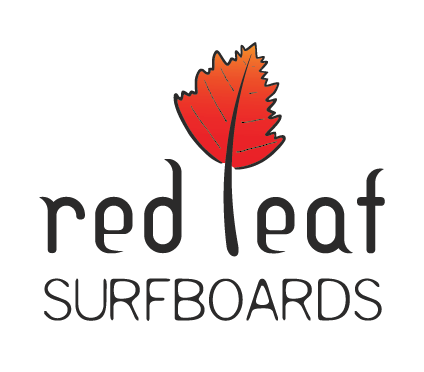
Board Construction
Hollow Timber / Skin and Frame:
This is the original technique we used when we first established Red Leaf. As trained furniture makers it was a natural choice for us to draw upon our experience and affinity with wood, a beautiful and sustainable material. We have evolved and fine tuned the technique over the years and it is the technique you will use if you were to join us on one of our workshop experiences.
Using a combination of the latest 3D design software and traditional woodworking techniques we build a timber skin around an internal plywood framework. By using lightweight locally grown Paulownia for the skins and rails and bio-based epoxy resins we create beautiful and functional boards made to last a lifetime riding waves.
Hollow timber surfboards do weigh in slightly heavier than a modern foam counterpart (approximately 20-25%) but we find that the extra bit of weight creates a very smooth positive ride and offers heaps of momentum. So if you’re into trim, flow and speed a timber board should be in your quiver.
Foam Core:
We started making foam core boards as we searched for a solution to make eco surfboards more affordable. We figured if we reduced the amount of labour per board we could pass that saving onto our customers. We still hold ourselves to the same high standards when it comes to quality, as we believe a long lasting durable board is the best approach to sustainability.
Our foam core boards utilise a recycled or reclaimed expanded polystyrene core which we shape and reinforce with natural woven cloths such as flax and basalt. Our locally grown Paulownia skins are vacuum pressed to the core before being wrapped with a laminated cork rail. The cork rail is hand shaped and the board is fine tuned before glassing.
We use bio-based epoxy resins to seal our foam core boards and while we do still require fibreglass cloth, the construction of our boards means we can reduce the amount required as we are using it to create a strong outer shell as opposed to relying on it for the overall strength of the board.
The foam core boards are more comparable to the weight of a ‘standard’ surfboard and the feel underfoot is quite familiar too. This construction is a good choice if you are looking to surf more vertically and aggressively.
Materials:
Paulownia Timber Paulownia Timber:
Paulownia is the second lightest wood to balsa and has one of the highest strength to weight ratios of all timbers. It can grow up to six meters in a year and absorb ten times more carbon dioxide than other trees. It works beautifully and has an incredible ability to form the compound curves found in surfboards. It doesn't absorb water to the same degree as other timbers and is resistant to fungal rot.
If that wasn’t enough, we source all our Paulownia from sustainably managed local forests making it the perfect choice for our sustainable surfcraft.
Bio-based Epoxy Resin:
To glass our boards we exclusively use a bio-based epoxy resin, that replaces toxic petrol chemical ingredients with plant based renewable co-products and waste products from other manufacturing processes. As a result the resin has a significantly reduced carbon footprint compared to conventional epoxies and low VOCs making them safer for the user and the environment.
The manufacturer also uses green chemistry techniques that require less energy and reduce harmful byproducts.
Cork:
Cork is a natural renewable and sustainable material which is non toxic and rot-proof. It is the harvested bark from cork oak trees not the actual tree itself, so once the cork is harvested it regenerates the bark which can be re-harvested again later in it’s life.
We have started using cork for the rails on our foam core boards and we make the move to using it for the rails on our hollow wooden boards in the future.
It has great flex & dampening properties which are great for the surfboards performance as well as having excellent impact resistance which is really good for the rails which are commonly areas of damage on surfboards.
Flax:
We use a Flax cloth under the Paulownia skins of the decks on our foam core boards. This reinforces the deck for incredible impact resistance meaning you won’t get pressure dings and will keep the deck of your board in mint condition.
The Flax cloth is a natural alternative to fibreglass with a low environmental impact. It is lightweight and has natural dampening properties which works well to reduce vibration and chatter.
In the Pipeline:
We have also made a small number of our foam core boards using a marine grade natural varnish for the waterproof coating, therefore removing the need for a fibreglass and resin finish. Although the end result made for a really lightweight beautiful board, we’re not yet 100% happy with the amount of time it takes to finish the boards to a standard we are happy with. We are working on it!




